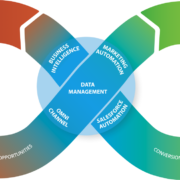Account Based Marketing and the Closed Loop Marketing Architecture
The focus on Account Based Marketing and it’s requirements has ignited a range of discussions and specialized B2B and ABM technologies and processes. For companies that are selling to accounts, the strategies associated with ABM are well understood, yet the technologies are still evolving. At first blush, you might think that a closed-loop marketing architecture doesn’t apply to B2B and account-based marketing. Closed Loop Marketing is data and insight-driven. It clearly works for B2C and high-volume campaigns. Yet, how does CLM apply to a highly relationship-centric account-based marketing focus?
Actually, closed-loop marketing is a core foundation for effective Account Based Marketing / ABM.
What is a Closed Loop Marketing Architecture?
We define Closed-Loop Marketing as a continuous flow or process for delivering highly tailored experiences that engage customers and drive conversions. By ‘closing the loop,’ teams align around the end-to-end customer lifecycle (across marketing and sales), and campaigns are measured for total revenue impact. We offer the Closed-Loop Marketing Architecture as a blueprint for campaign design and execution. It describes the critical elements and flows of a modern marketing and sales campaign.
Six steps and five systems are needed for CLM, and in this article, we explore these and how they align with account-based marketing principles.
The Six Steps of Closed Loop Marketing – Aligned with Account-Based Marketing Principles
1) Analysis. This step is universal to any campaign. It identifies trends from recent account interactions and campaign engagement life cycles. Marketers produce behavioral and predictive insights by reviewing data, performance, and metrics of recent campaigns. With Account-Based Marketing, the analysis also includes preferences and account-level insights that go beyond the typical B2B inbound or B2C campaign. The strategy begins at the account level and is informed by the account plan.
2) Insights: This step in the flow is relevant to the ABM approach. It is critical to understand different buyer personas in complex sales to committee buyers. In this step, you can develop and enhance the account profile as well as define specific customer profiles within the account, incorporating personas, segmentation and value metrics.
3) Opportunities: Account plans help drive out specific strategies for account penetration, and opportunities are also informed by the insights from prior interactions and campaigns. Marketing and sales teams prioritize opportunities and strategies to capture customer value, and they mobilize resources to launch account-based marketing and sales programs.
4) Campaigns: Account-based Marketing campaigns are highly tailored and typically compliant with strict protocols associated with each account. It is more crucial to control exacting communications at a 1:1 level and programs are tightly integrated across marketing and sales. Team members work together to engage segments, decision-makers, and influencers within the account. The web plays a key role in delivering relevant/personalized experiences and communications throughout the account driven by roles, preferences, interests, and behaviors. Ideally, account contacts are registered and engaged in the marketing messages and programs that impact both new acquisitions and expansion.
5) Engagement: Account-based Marketing experiences engage contacts within accounts with personalized messages and help nurture customer relationships. Engagement is also critical after the sale to maximize total funnel impact. Revenue systems help capture customer profiles and build a 360-degree view informed by intents, context, actions, and behaviors across all channels and systems.
6) Conversions: Campaigns and account teams orchestrate leads, prospects and customers through the marketing-sales lifecycle, responding to customer behaviors and key performance indicators. In account based marketing, conversions are engineered to optimize the total revenue funnel – at each stage – recognizing the complexities in customer nurture/ prospect care.
Five Underlying Systems Critical to Account-Based Marketing
1) Omni-Channel: The website plays a central role in account-based marketing engagement, along with events, digital advertising, direct sales, and account teams. Accounts are engaged with an optimal mix of B2B-focused paid, owned, and earned media to deliver account-level and customer-specific experiences and interactions across the customer lifecycle.
2) Marketing Automation: Teams configure and integrate campaigns using business rules to engage audience segments at different stages of the buying cycle and based on different role ‘personas’. Optimization around conversions, sales nurture programs, qualification, and lead scoring helps generate and maintain marketing-qualified opportunities.
3) Salesforce Automation: The features of salesforce automation / CRM are at the center of account-based marketing. Account team coordination, contact management, and deal management are all central, along with account and contact intelligence. CRM enables sales effectiveness using tools, intelligence, assets, and services that track and manage customer relationships, including contacts, account information, opportunity management, and service interactions.
4) Business Intelligence: ABM Marketers use tools, applications, and methodologies to develop and run queries and create reports, dashboards, and data visualizations that enable more predictive and informed decision-making about accounts, specific contacts, and campaign performance.
5) Data Management: Data Management is a foundation requirement that applies to ABM. Teams collect, store, index, and harmonize internal, external, current, and historic customer data to enable a 360-degree view of both the account and the customer and help define relevant communications.
Account-Based Marketing and Closed Loop Marketing – Perfectly Aligned
Closed-loop marketing is a central foundation for effective Account Based Marketing / ABM. The Account-Based Marketing Consortium (AccountBased.Marketing ) is a consortium of B2B marketing technology leaders focused on delivering ABM solutions. The consortium describes a set of defining characteristics for successful Account Based Marketing programs. These align directly with the Closed Loop Marketing Architecture approach. Here we describe how to map these principles into the continuous engagement approach of the CLMA:
- Account selection is tied to the analysis and insights stage of the CLMA and is a core entrance criteria for an ABM campaign or program.
- Insights – This is a direct alignment with the CLMA “Insights” stage.
- Content—Content is assumed to be central to any campaign experience and is not unique to ABM. However, the type of content required in ABM programs is much more tailored and personalized. These are defined in the “Opportunities” stage and then implemented in Campaigns, driving the experience and engagement.
- Orchestration – We agree that account orchestration is critical to ABM. It is the collection and coordination of engagement that drives the impact. We address this element in the “Opportunities” stage as we integrate campaign designs across channels and tactics.
- Targeted delivery – We address targeted delivery in campaign design (opportunity) and execution (campaigns) in ABM, we recognize how important it is to align and tailor communications to specific account influencers.
- Measurement—The CLMA describes a range of systems (Business Intelligence and Data Management) and steps (Analysis and Insights) to ensure that campaigns are optimized and meeting target goals.
To learn more, please contact us for a complete briefing on the CLMA and how it can be applied to your complex B2B sales and account-based marketing strategies.



Leave a Reply
Want to join the discussion?Feel free to contribute!